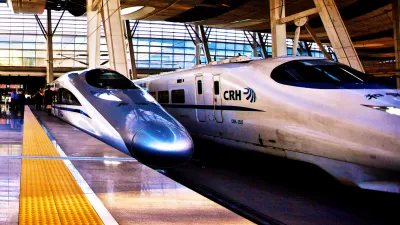The opening of the 1,200-mile Beijing to Guangzhou high-speed rail line marked the latest milestone in "one of the world’s largest and most ambitious infrastructure projects." The longest such segment in the world takes only 8 hours to traverse.

At a speed of 300 kilometers, or 186 miles, an hour, China's latest infrastructure marvel covers a distance similar to that between New York and Key West, Fla. in only 8 hours. Amtrak trains from New York to Miami take 30 hours. According to Keith Bradsher, the latest milestone - which means the country has completed 5,809 miles of high-speed lines in just over four years - is not just significant for train enthusiasts; it's having a notable impact on China's economy and environment.
"Lavish spending on the project has helped jump-start the Chinese economy twice: in 2009, during the global financial crisis, and again this autumn, after a brief but sharp economic slowdown over the summer," says Bradsher. "The hiring of as many as 100,000 workers for each line has kept a lid on unemployment as private-sector construction has slowed because of limits on real estate speculation. The national network has helped to reduce air pollution in Chinese cities and helped to curb demand for imported diesel fuel by freeing capacity on older rail lines for goods to be carried by freight trains instead of heavily polluting, costlier trucks."
"But the high-speed rail system has also been controversial in China. Debt to finance the construction has reached nearly 4 trillion renminbi, or $640 billion, making it one of the most visible reasons total debt has been surging as a share of economic output in China, and is approaching levels in the West."
FULL STORY: China Opens Longest High-Speed Rail Line

Maui's Vacation Rental Debate Turns Ugly
Verbal attacks, misinformation campaigns and fistfights plague a high-stakes debate to convert thousands of vacation rentals into long-term housing.

Planetizen Federal Action Tracker
A weekly monitor of how Trump’s orders and actions are impacting planners and planning in America.

In Urban Planning, AI Prompting Could be the New Design Thinking
Creativity has long been key to great urban design. What if we see AI as our new creative partner?

King County Supportive Housing Program Offers Hope for Unhoused Residents
The county is taking a ‘Housing First’ approach that prioritizes getting people into housing, then offering wraparound supportive services.

Researchers Use AI to Get Clearer Picture of US Housing
Analysts are using artificial intelligence to supercharge their research by allowing them to comb through data faster. Though these AI tools can be error prone, they save time and housing researchers are optimistic about the future.

Making Shared Micromobility More Inclusive
Cities and shared mobility system operators can do more to include people with disabilities in planning and operations, per a new report.
Urban Design for Planners 1: Software Tools
This six-course series explores essential urban design concepts using open source software and equips planners with the tools they need to participate fully in the urban design process.
Planning for Universal Design
Learn the tools for implementing Universal Design in planning regulations.
planning NEXT
Appalachian Highlands Housing Partners
Mpact (founded as Rail~Volution)
City of Camden Redevelopment Agency
City of Astoria
City of Portland
City of Laramie


























